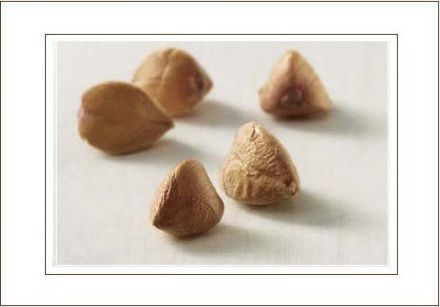 |
Buckwheat
Buckwheat belongs to the same family as sorrel and rhubarb. It is not technically a cereal from the botanical point of view.
History
Buckwheat originated in Central Asia (Siberia and Northern China). In the Middle Ages, it arrived in Europe. The Saracens, or Moors, for whom buckwheat was a staple food, introduced it into Europe during the Crusades. It arrived in France in the 15th century, where it became particularly popular in the northwest (Brittany).
Sarrasin is a rustic plant that does well in poor soil, requiring little fertilizer to grow quickly. It is ideal for organic agriculture because it is very resistant and does not require the use of herbicides. One interesting fact is that the grains do not all ripen at the same time.
Today buckwheat is grown in damp temperate climates, for example in Russia, Poland, Canada, Japan and France (Brittany).
Buckwheat is a natural source of protein. It contains the eight essential amino acids, some of which are found mostly in animal proteins, as well as high amounts of magnesium and calcium (more than wheat). Rich in fiber and antioxidants, this grain contains no gluten, is easy to digest and promotes intestinal transit.
Very nutritious, buckwheat is also an excellent remineralizer.
- 402 calories
- 15.1 g protein
- 84.7 g carbohydrates
- 3.7 g fat
- 11.2% water
Rich in
- magnesium, potassium and zinc
- phosphorus, copper and fluoride
- riboflavin
- iron and calcium
- vitamins B and P
Buckwheat grains can be eaten whole (kasha), roasted or cracked, or as flour of various grinds used in pancakes (buckwheat galettes), breads and noodles (soba). It is also available as flakes.
No preparation is required.
Heat the buckwheat grains in a dry saucepan to toast them and bring out the flavor. Add two and a half times their volume of boiling water. Cook gently for about 15 minutes.
The grains are sometimes eaten like cereals (rice and wheat), particularly in Poland, Russia and Ukraine (grietchka). They can also be ground. The sharp tasting flour is used to make flat breads and pancakes, particularly in Brittany and Cantal (under the name bourriols), Japanese noodles (soba), couscous or porridge (kasha, eaten for breakfast in Eastern Europe).

-

 Recipes
Recipes
-

 Products
Products
-

 Entertaining
Entertaining
-

 Chefs
Chefs
-

 Hints & Tips
Hints & Tips
-

 Glossaries
Glossaries








